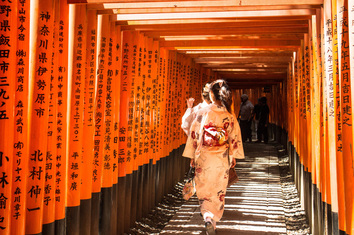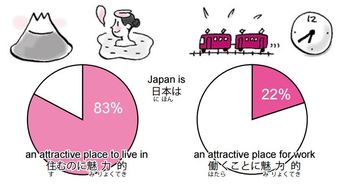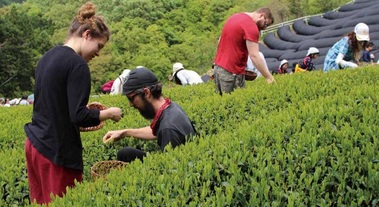Popularity of Torii in a Natural Setting
自然の中で際立つ鳥居が人気
自然の中で際立つ鳥居が人気
along - at - behind - by - for - from - in
of - over - through - to - under - with
of - over - through - to - under - with
Fushimi-Inari Taisha Shrine (1 ) Kyoto City, Kyoto Prefecture is a popular destination (2 ) overseas travelers. It came out top on Trip Advisor’s list of “Tourist Destinations in Japan 2015.” To get there you take the train (3 ) JR Kyoto Station and travel two stops (4 ) Inari Station. Here there is a huge red torii (gate to a shrine) that stands (5 ) the top of Omotesando Avenue (the main approach). After visitors pass (6 ) the second torii, they encounter a roumon (two-story) gate which is said to have been built (7 ) Hideyoshi Toyotomi – the general who unified Japan.
京都府京都市にある伏見稲荷大社は、海外からの旅行客に人気の場所です。「トリップアドバイザー」による「外国人に人気の日本観光スポット2015」で1位になりました。JR 京都駅から電車で2駅目の稲荷駅で降りると、巨大な赤い鳥居があり、表参道につながります。2つ目の鳥居をくぐると、日本を統一した武将、豊臣秀吉が建てたという楼門が現れます。
On entering the gate, visitors encounter the main shrine dedicated (8 ) the deity “Oinari-san.” One of the peculiarities (9 ) this shrine is its symbolic white fox. The fox is thought to be a messenger (10 ) the gods and is said to protect rice crops. This place is the head temple (11 ) all the Inari Shrines located around the country. Its main object of worship is Mt. Inari, which is located (12 ) the shrine. 中へ入ると本殿がありますが、「お稲荷さん」と呼ばれる神様が祭られています。シンボルとなっている白い狐の像があるのが特徴です。狐は神様のお使いとされ、稲を守るといわれています。ここは、全国各地にある稲荷神社の総本宮で、背後に広がる稲荷山全体が信仰の対象となっています。
The tightly-packed torii built in rows (13 ) the approach to Mt. Inari are called Senbon-torii, and are particularly popular (14 ) visitors. Passing (15 ) these is like entering a tunnel which forks right and left midway becoming two passages that run parallel. Construction of the torii began (16 ) the Edo era, thanks to offerings made (17 ) pilgrims. The senbon torii spread (18 ) the entire Mt. Inari area. 稲荷山へ続く参道にすき間なく建てられた鳥居は千本鳥居と呼ばれており、特に人気です。トンネルに入るように進むと、途中から左右二本に分かれ並行した鳥居になります。江戸時代から参拝者の奉納で建てられ始めました。鳥居は稲荷山全体に約1万基あります。
京都府京都市にある伏見稲荷大社は、海外からの旅行客に人気の場所です。「トリップアドバイザー」による「外国人に人気の日本観光スポット2015」で1位になりました。JR 京都駅から電車で2駅目の稲荷駅で降りると、巨大な赤い鳥居があり、表参道につながります。2つ目の鳥居をくぐると、日本を統一した武将、豊臣秀吉が建てたという楼門が現れます。
On entering the gate, visitors encounter the main shrine dedicated (8 ) the deity “Oinari-san.” One of the peculiarities (9 ) this shrine is its symbolic white fox. The fox is thought to be a messenger (10 ) the gods and is said to protect rice crops. This place is the head temple (11 ) all the Inari Shrines located around the country. Its main object of worship is Mt. Inari, which is located (12 ) the shrine. 中へ入ると本殿がありますが、「お稲荷さん」と呼ばれる神様が祭られています。シンボルとなっている白い狐の像があるのが特徴です。狐は神様のお使いとされ、稲を守るといわれています。ここは、全国各地にある稲荷神社の総本宮で、背後に広がる稲荷山全体が信仰の対象となっています。
The tightly-packed torii built in rows (13 ) the approach to Mt. Inari are called Senbon-torii, and are particularly popular (14 ) visitors. Passing (15 ) these is like entering a tunnel which forks right and left midway becoming two passages that run parallel. Construction of the torii began (16 ) the Edo era, thanks to offerings made (17 ) pilgrims. The senbon torii spread (18 ) the entire Mt. Inari area. 稲荷山へ続く参道にすき間なく建てられた鳥居は千本鳥居と呼ばれており、特に人気です。トンネルに入るように進むと、途中から左右二本に分かれ並行した鳥居になります。江戸時代から参拝者の奉納で建てられ始めました。鳥居は稲荷山全体に約1万基あります。
above - along - at - by - for - from - in
of - on - through - to - up - upon - with
of - on - through - to - up - upon - with
After passing (19 ) the Senbontorii, visitors come upon the Omokaruishi stone lanterns. Here it’s possible to try lifting a round stone (20 ) the top; if it is light your wish will be granted and if it feels heavy, it will be difficult. On a holiday this area fills up (21 ) supplicants. 千本鳥居を抜けると、おもかる石と呼ばれる石灯篭があります。灯篭の先端にある丸い石を持ち上げることができ、軽く感じれば願いが叶い、重ければ叶いにくいといわれています。休日になると願掛けをする人たちでにぎわいます。
At the shrine it is customary to write your wishes down (22 ) a wooden board called an ema, which you then leave as an offering. Ema (23 ) Fushimi-Inari Taisha Shrine are unique in that they are made (24 ) the shape of a fox face. Many people add a nose and a mouth (25 ) themselves. After being depicted (26 ) popular comic books, Fushimi-Inari Taisha Shrine has been visited (27 ) many manga fans. 神社では絵馬と呼ばれる木の板に願いごとを書て、奉納する風習があります。伏見稲荷大社の絵馬はユニークな狐の顔の形をしています。多くの人が自分の好きなように鼻や口を描き足します。伏見稲荷大社を舞台にした人気まんががあることから、ファンも多く訪れます。
At 233 meters (28 ) sea level, Mt. Inari is also a popular spot (29 ) hiking. Because the torii lead all the way up (30 ) the summit, it’s impossible to get lost. When standing (31 ) the top of the mountain after walking (32 ) the stone steps, visitors come (33 ) a view of south Kyoto. It takes approximately two hours to go there and back. There is a teahouse (34 ) the way. 海抜233メ ートルの稲荷山は、ハイキングコースとしても親しまれています。山頂まで鳥居が続いているので、迷うことがありません。石段の階段を上って頂上へ立つと、京都市の南部が一望できます。往復約2時間で歩くことができ、途中で休憩できる茶屋もあります。
The route (35 ) Fushimi-Inari Taisha Shrine to Keihan Fushimi-Inari Station is called Urasando Avenue (back approach). Restaurants, souvenir shops, and street stalls line this street. Fox face-shaped senbei are popular souvenirs. (36 ) addition, a kind of sushi called Oinari-san is sold in honor (37 ) the fox god. 伏見稲荷大社から京阪伏見稲荷駅までの道は、裏参道と呼ばれ、飲食店や土産物屋、露店が立ち並んでいます。狐の顔の形をしたおせんべいが、お土産人気です。また神様と同じように、お稲荷さんと呼ばれる寿司も販売されています。
At the shrine it is customary to write your wishes down (22 ) a wooden board called an ema, which you then leave as an offering. Ema (23 ) Fushimi-Inari Taisha Shrine are unique in that they are made (24 ) the shape of a fox face. Many people add a nose and a mouth (25 ) themselves. After being depicted (26 ) popular comic books, Fushimi-Inari Taisha Shrine has been visited (27 ) many manga fans. 神社では絵馬と呼ばれる木の板に願いごとを書て、奉納する風習があります。伏見稲荷大社の絵馬はユニークな狐の顔の形をしています。多くの人が自分の好きなように鼻や口を描き足します。伏見稲荷大社を舞台にした人気まんががあることから、ファンも多く訪れます。
At 233 meters (28 ) sea level, Mt. Inari is also a popular spot (29 ) hiking. Because the torii lead all the way up (30 ) the summit, it’s impossible to get lost. When standing (31 ) the top of the mountain after walking (32 ) the stone steps, visitors come (33 ) a view of south Kyoto. It takes approximately two hours to go there and back. There is a teahouse (34 ) the way. 海抜233メ ートルの稲荷山は、ハイキングコースとしても親しまれています。山頂まで鳥居が続いているので、迷うことがありません。石段の階段を上って頂上へ立つと、京都市の南部が一望できます。往復約2時間で歩くことができ、途中で休憩できる茶屋もあります。
The route (35 ) Fushimi-Inari Taisha Shrine to Keihan Fushimi-Inari Station is called Urasando Avenue (back approach). Restaurants, souvenir shops, and street stalls line this street. Fox face-shaped senbei are popular souvenirs. (36 ) addition, a kind of sushi called Oinari-san is sold in honor (37 ) the fox god. 伏見稲荷大社から京阪伏見稲荷駅までの道は、裏参道と呼ばれ、飲食店や土産物屋、露店が立ち並んでいます。狐の顔の形をしたおせんべいが、お土産人気です。また神様と同じように、お稲荷さんと呼ばれる寿司も販売されています。





 RSS Feed
RSS Feed